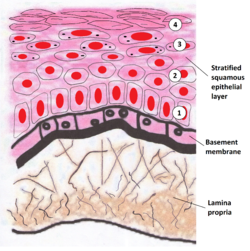基底膜
基底膜(basement membrane)又称基膜[1]、底膜[2],以区别耳蜗之基底膜(basilar membrane),是一层特化薄而柔韧的胞外基质(无细胞薄膜状结构),位于上皮细胞基底面与深部结缔组织间,可提供细胞和组织支持并充当复杂信号传导的平台[3][4][5]。
| 基底膜 | |
|---|---|
 基底膜及上皮表示图 | |
 | |
| 标识字符 | |
| 拉丁文 | membrana basalis |
| MeSH | D001485 |
| TH | H2.00.00.0.00005 |
| FMA | FMA:63872 |
| 《显微解剖学术语》 [在维基数据上编辑] | |
组成
编辑基底膜是由基板[6](basal lamina)及网板[7](reticular lamina)两者所组合而成。两者以固定纤维(anchoring fibrils)(第七型胶原蛋白)和纤维蛋白原紧密结合。[8]
基板又可以再分为两层,较清澈且较靠近上皮的称为透明层(lamina lucida),较致密且较靠近连结组织的称为致密层(lamina densa)。致密层由基底膜聚糖构成[9],厚度约30~70奈米之间,上下有第四型胶原蛋白构成纤维(平均直径约30奈米)所组成的网状组织(约0.1~0.2奈米厚)加以固定。
基底膜的构造如下:
- 上皮组织(外层)
- 基底膜(basement membrane)
- 结缔组织(内部)
功能
编辑疾病
编辑部分基底膜的疾病是由于功能衰竭,可能导因于基因缺陷、受伤、免疫系统退化或其他原因。[13]
- Alport syndrome:基底膜的胶原纤维基因缺陷会造成。
- 古德帕斯彻氏症候群(Goodpasture's syndrome) [14]
- 表皮溶解水疱症(epidermolysis bullosa):许多基底膜功能异常疾病的统称,台湾俗称“泡泡龙”。
参考
编辑注释
编辑- ^ 存档副本. [2024-02-29]. (原始内容存档于2024-02-29).
- ^ 存档副本. [2024-02-29]. (原始内容存档于2024-07-22).
- ^ Pozzi A, Yurchenco PD, Iozzo RV. The nature and biology of basement membranes. Matrix Biology. January 2017, 57–58: 1–11. PMC 5387862 . PMID 28040522. doi:10.1016/j.matbio.2016.12.009.
- ^ Sekiguchi R, Yamada KM. Basement Membranes in Development and Disease. Current Topics in Developmental Biology. 2018, 130: 143–191. ISBN 9780128098028. PMC 6701859 . PMID 29853176. doi:10.1016/bs.ctdb.2018.02.005.
- ^ Kierszenbaum, Abraham; Tres, Laura. Histology and Cell Biology, An Introduction to Pathology 3rd. Elsevier. 2012. ISBN 978-0-323-07842-9.
- ^ 存档副本. [2024-02-29]. (原始内容存档于2024-02-29).
- ^ 存档副本. [2024-02-29]. (原始内容存档于2024-02-29).
- ^ Paulsson M. Basement membrane proteins: structure, assembly, and cellular interactions. Crit. Rev. Biochem. Mol. Biol. 1992, 27 (1-2): 93–127 [2013-02-05]. PMID 1309319. doi:10.3109/10409239209082560. (原始内容存档于2014-04-07).
- ^ Noonan DM, Fulle A, Valente P; et al. The complete sequence of perlecan, a basement membrane heparan sulfate proteoglycan, reveals extensive similarity with laminin A chain, low density lipoprotein-receptor, and the neural cell adhesion molecule. J. Biol. Chem. December 1991, 266 (34): 22939–47 [2013-02-05]. PMID 1744087. (原始内容存档于2020-04-18).
- ^ Noonan DM, Fulle A, Valente P; et al. The complete sequence of perlecan, a basement membrane heparan sulfate proteoglycan, reveals extensive similarity with laminin A chain, low density lipoprotein-receptor, and the neural cell adhesion molecule. J. Biol. Chem. December 1991, 266 (34): 22939–47 [2013-02-05]. PMID 1744087. (原始内容存档于2020-04-18).
- ^ Liotta LA, Tryggvason K, Garbisa S, Hart I, Foltz CM, Shafie S. Metastatic potential correlates with enzymatic degradation of basement membrane collagen. Nature. March 1980, 284 (5751): 67–8 [2013-02-13]. PMID 6243750. doi:10.1038/284067a0. (原始内容存档于2017-06-20).
- ^ Kubota Y, Kleinman HK, Martin GR, Lawley TJ. Role of laminin and basement membrane in the morphological differentiation of human endothelial cells into capillary-like structures. J. Cell Biol. October 1988, 107 (4): 1589–98 [2013-02-13]. PMC 2115245 . PMID 3049626. doi:10.1083/jcb.107.4.1589. (原始内容存档于2020-05-26).
- ^ Henig, Robin Marantz. What’s Wrong With Summer Stiers?. New York Times. February 22, 2009 [2013-02-13]. (原始内容存档于2014-05-09).
- ^ Janeway, Charles; Janeway, Charles A. Immunobiology 5th. Garland. 2001. ISBN 978-0-8153-3642-6.
参考文献
编辑- Kefalides, Nicholas A. & Borel, Jacques P. (编). Basement membranes: cell and molecular biology. Gulf Professional Publishing. 2005 [2013-02-05]. ISBN 978-0-12-153356-4. (原始内容存档于2013-05-09).